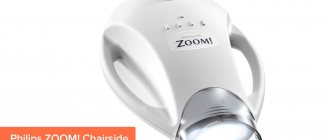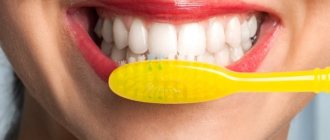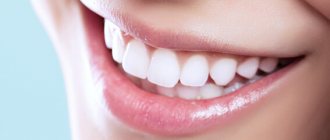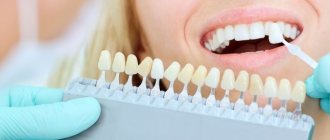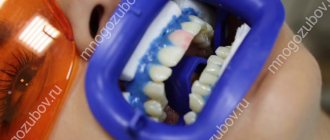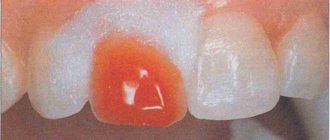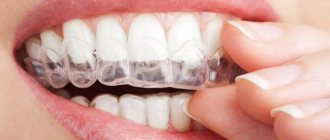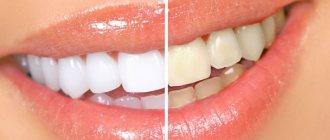Endo-whitening (lightening the tooth from the inside) - features and technology of the procedure
Some time after the removal of extensive carious destruction and depulpation, the tooth may darken, and this phenomenon is not uncommon. The crown changes color first, followed by the root system. And if earlier such a problem was solved by installing a crown or veneer, now in dentistry the technology of intra-canal teeth whitening - endo-whitening - is actively used. Read more about what it is, how the procedure is carried out and what features are typical for it in our material.
Achieved effect and possible complications
The result obtained after endobleaching usually lasts for up to one year. After this period has expired, it is recommended to repeat the procedure.
Attention! Many patients choose this procedure because of its safety, lack of pain, and also a targeted effect on one specific tooth, preserving its natural shape and without affecting neighboring ones.
Specialists of the Department of Dentistry of SSMU named after. Razumovsky conducted a study on intracanal teeth whitening. The statistics obtained indicate that the procedure is effective in 83% of cases. When performing endobleaching procedures, only a few patients experience some sensitivity in the treated area. The sensations are similar to bloating and a slight increase in temperature in the tooth. However, the result of the procedure satisfies all patients.
When eliminating aesthetic defects by endobleaching, the strength of the tooth is weakened, because the chemical effect occurs in the “dead” tooth. In this regard, it is necessary to use a minimum number of whitening procedures so as not to lead to crown destruction.
Among the negative points can be noted:
- Impossibility of bleaching without replacing colored filling materials.
- Possible increase in tooth fragility, weakened by frequent endobleaching.
- The need to use a drill and several visits to the dental office.
What can cause a tooth to darken and when is it time to whiten it?
Dentin can change its color for many reasons, and here we must immediately make a reservation that the procedure in question is indicated exclusively for pulpless units. Before bleaching, the doctor will have to remove the nerve, if this has not been done previously. If the canals have already been sealed, it will be necessary to remove the material and carry out appropriate treatment of the internal structures.
As for the most common causes of the problem, here experts in the field of dentistry primarily highlight pulp necrosis, that is, its gradual death due to destructive pathological processes, pulpitis. Another possible option is hemorrhage into the neurovascular bundle, when blood stains the tissue from the inside. You can count on restoration of aesthetics only if there is a chance to save the pulp. In all other situations, teeth whitening will help.
On a note! If the canals have already been filled, and darkening occurs some time after treatment, then the cause may be prolonged contact of living tissue with the filling material. Thus, the resorcinol-formalin composition can make the crown slightly pinkish, and the silver material will over time acquire a dark gray tint, and the tooth will noticeably fade.
These processes are also promoted by foods with intense coloring pigments, smoking, and coffee abuse. Age plays a role in this problem - over time, hard tissues weaken and become covered with microcracks, which create favorable conditions for the accumulation of plaque and bacteria. As a result, the enamel becomes yellow or even grayish, but today there is a solution to this problem - endobleaching.
Internal tooth whitening - possibilities and limitations
Problem: the patient came to see the dentist with a complaint that his front tooth had darkened.
Solution: tooth canal treatment under a microscope and internal tooth whitening were performed.
First, it was necessary to find out why the front tooth darkened. According to the patient, this tooth was treated a long time ago. An x-ray of the tooth was taken. Based on the diagnostic results, it turned out that the treatment of the tooth canals was not completed completely. Organic substances remained in the tooth, which caused the darkening of the tooth. The reason why the front tooth has darkened can be removed only by re-treating the tooth canals with a microscope. The treatment of tooth canals with a microscope was carried out by endodontist T.I. Matienko. The cost of canal treatment with a microscope is 20 thousand rubles. A dental microscope significantly improves the quality of treatment when in the hands of experienced Dial-Dent endodontists. The treatment estimate is provided to the patient and agreed upon with him before the doctor begins to act.
As a result of re-treatment of the tooth canals with a microscope, the color of the tooth became lighter, but not yet enough.
It is impossible to change the color of a tooth using conventional methods of teeth whitening from the outside, since it is not the enamel that has darkened, but the tooth tissue inside, and the dark color only shows through the enamel.
Dental doctors always offer several ways to solve the problem for patients. This patient was told about possible ways to lighten a tooth after root canal treatment:
- endodontically whiten the tooth (carry out internal tooth whitening);
If this is not enough:
- carry out artistic restoration of the front tooth using the latest generation materials or install a ceramic veneer on the tooth.
As with any teeth whitening, with internal tooth whitening it is impossible to predict the result 100%, which the doctor warns the patient about. The degree of whitening can be different for each patient, as it depends on the degree of staining, the thickness of the enamel, the structure of the tooth tissue, and the age of the patient. Dial-Dent dentists have extensive experience in teeth whitening, therefore, if it is proposed to whiten a tooth, then the probability of a good result is quite high.
Internal teeth whitening was performed by dentist Yu.A. Borisova. A special whitening agent was placed into the tooth canals for 2 days. After the first procedure, the tooth color became much lighter.
After the second procedure of laying the material, the tooth acquired an almost natural color.
Further bleaching, according to the doctor’s experience, will not bring improvement. The result was discussed with the patient and it was decided to restore the front teeth with veneers, which will improve their shape and color. Internal tooth whitening was necessary, since veneers are very thin ceramic plates that have the transparency of natural enamel. If you leave the tooth too dark, the dark color will show through the veneer.
To visualize the results of internal whitening, evaluate the color of the tooth at different stages:
Internal teeth whitening costs 2,500 rubles per application of material. Ceramic veneer costs from 18,500 rubles.
The result of the tooth restoration with veneer will be posted later, since the restoration has been postponed for the time being due to the patient’s personal reasons.
You can find out how to do teeth whitening in Moscow and how much teeth whitening costs during a face-to-face consultation with Dental specialists.
See other examples of teeth whitening here.
Features of the technique and drugs used
It may take more than one session to achieve the desired result. The procedure itself involves the introduction of a concentrated whitening composition into the tooth cavity, which is then closed with a temporary filling. After some time (the doctor himself will set the date for the next visit), the dentist will be able to evaluate the effectiveness of the previous session and, if necessary, perform another procedure or complete the course.
This is interesting! The technique of lightening pulpless teeth was first used back in 1864. However, specialists achieved the desired results only in the 70s of the last century, when they began to use an aqueous solution of sodium perborate1.
The procedure is completely painless and safe and lasts 20-30 minutes. The maximum number of sessions is 4 visits with an interval of 1-2 weeks. In dentistry, special whitening preparations from Opalescence Endo (USA), Whiteness Perborate (Brazil) and other brands are used for this purpose. Too frequent and repeated introduction of bleaching components can cause burns and subsequent destruction of hard tissues.
Whitening methods
How to whiten a darkened tooth? Two methods are used.
Endobleaching
The method involves injecting bleaching agents into the crown. For this purpose, a product based on sodium perborate is used. The procedure is carried out not only when the pulp is removed, but also in cases where it is impossible to change the shade in other ways:
- injury followed by internal hemorrhage;
- a filling was installed with formaldehyde, which stains dentin pink;
- As a result of silvering, the roots darkened.
The algorithm is as follows:
- Professional cleaning is carried out.
- Old fillings are removed and root canals are cleaned.
- A bleaching compound is injected into the cavity.
- A temporary filling is placed.
One of the methods is endobleaching.
The procedure is repeated at weekly intervals until the result is visible. Typically, 4-5 visits are needed to lighten a tooth. The filling is placed 10 days after the last gel placement procedure.
The result is noticeable on average within two years; after that you will have to repeat the cycle. It is not recommended to conduct more than three courses of intracanal bleaching. Each subsequent cycle increases the risk of crown fracture.
The technique has other disadvantages :
- The result cannot be predicted immediately; it will be clear only after completing the course.
- The enamel becomes lighter, but remains dull and differs from neighboring units.
- There are contraindications: allergies, pregnancy, caries, gum disease, endocrine disorders, cracks, the presence of photopolymer fillings.
Veneers
Restorative bleaching means covering the surface with thin plates - veneers. They come in two types:
- Ceramic - made of porcelain or zirconium dioxide. The similarity to natural fabrics is achieved due to increased transparency. Such models are durable, so they are placed on chewing teeth.
- Composite - affordable, but less strong and durable. Their service life does not exceed five years.
Veneers are a reliable, durable and aesthetic way to restore a beautiful appearance to a tooth.
The procedure has the following steps :
- The required shade of the plate is selected.
- The tissue is sanded off the surface (from 0.5 to 1.5 mm).
- Zirconium dioxide veneers are made on a special machine based on a three-dimensional computer image. Porcelain plates are ground in dental laboratories using a plaster cast.
- Finished veneers are fixed to the surface using special glue.
- Composite plates are made both in the laboratory using an impression and directly in the patient’s mouth, when a filling composite material is applied to the prepared surface.
Restoration is not carried out if there are contraindications:
- malocclusion;
- severe tooth decay;
- washability;
- risk of injury (during sports activities, for example);
- bruxism.
You can install a ceramic crown.
When deciding to install veneers, it is important to understand that you will have to wear them for the rest of your life. The technique involves less grinding than for crowns, but it still exists; It will not be possible to restore your teeth to their original appearance.
Indications for endobleaching
There is a list of indications for which intracanal bleaching will be an effective method of solving the problem. Here are the main ones:
- a pulpless tooth or a nerve to be removed,
- age-related structural changes in hard tissues that are no longer amenable to traditional correction methods,
- discoloration due to overuse of coffee, strong tea and other drinks, as well as products with intense coloring pigments. Due to constant exposure to tobacco smoke,
- hemorrhage into the pulp,
- staining of hard tissues, impact of filling material,
- pulp necrosis as a consequence of advanced forms of caries, pulpitis, periodontitis.
The appropriateness of using this technique in each individual case is decided by a specialist. In the matter of choice, the degree of color change and the reason that caused the problem play an important role.
Causes of darkening
Each chewing unit consists of roots and a crown. Below the crown is the pulp chamber containing the pulp called the nerve. Blood vessels and nerve endings pass through the pulp, supplying the tooth with nutrients.
A dead tooth is one from which the pulp has been removed.
After removal of the nerve, strong enamel continues to perform its functions and remains in the gum. But the necessary substances do not reach it, the dentin dries out, and the tissue begins to darken. Another reason for discoloration is damage to the blood vessels when the nerve is removed. Blood quickly stains dentin, and it is useless to bleach the surface using traditional methods.
What are the contraindications
Like any other dental procedure, the endobleaching technique has a number of restrictions on its use. The main contraindications are listed below:
- hyperesthesia (sensitive enamel),
- signs of periodontal disease,
- inflammatory processes in the tissues of the oral cavity,
- pathological abrasion,
- periodontal tissue diseases,
- the presence of microtraumas, chips and cracks,
- progressive carious processes,
- chronic diseases associated with the thyroid gland,
- pregnancy and lactation period.
Also, the procedure is not performed on children and adolescents under 16 years of age. If the tooth has been depulped and filled long ago, you will have to remove the material and do everything again.
Does endobleaching have side effects?
The peculiarity of the bleaching process is that it chemically destroys protein dyes, as well as coloring substances contained in fillings. This is why there is always a risk of not getting as great results as expected.
Also, endobleaching of a pulpless tooth significantly reduces its strength. After all, microdamages from the procedure are not restored in a dead tooth. As a result, the risk of one day getting a dental crown fracture increases. This is why internal bleaching should not be done more than four times.
Contraindications for internal bleaching Endo-bleaching is contraindicated for caries, periodontitis, and the presence of old fillings with a changed color. The procedure should also not be used on children and adolescents under sixteen years of age because their teeth are still developing. Pregnancy, breastfeeding, allergies to hydrogen peroxide and increased tooth sensitivity complete the list of main contraindications.
Stages of intracanal bleaching
After all preparatory measures, the patient is invited directly to the procedure. To begin with, the specialist will ask you to rinse your mouth with an antiseptic solution to eliminate the risk of infection. Next, the clarification process will follow the following steps:
- choosing the desired shade,
- isolation of the working area from neighboring teeth,
- removing old filling material,
- cleaning and treatment of canals,
- fixing the insulating gasket to avoid penetration of the composition into the channels,
- sealing with a temporary filling.
After 7-10 days, the patient should return for a follow-up appointment. The dentist will evaluate the achieved result and decide on the need to re-administer the drug. Usually it takes 2 to 4 sessions to achieve the desired effect. Upon completion of the course, a permanent filling is fixed instead of a temporary one.
teeth whitening with fillings
The fashion for snow-white teeth originated in the USA, a country where people smile with or without reason. However, in different countries and in other eras, the traditions were completely different: for example, the Hindus painted their teeth brown, and in Ancient Japan - women inked them with a special paint based on iron and vinegar - it was believed that since the black color always remains black, so Fidelity to your spouse will also remain constant. A similar ritual still exists among the Dusuns, a tribe on the island of Borneo: their teeth are covered with a strip of banana leaf for 40 hours, while they are not allowed to drink or eat - beauty, as we know, requires sacrifice.
Today, the legendary “Hollywood smile” is an indicator of high status and good health, an expression of sympathy, goodwill and just a good mood. Modern whitening technologies are actively developing: light, infrared, plasma and laser systems help achieve the desired effect. However, you can whiten your teeth at home - it costs much less, however, the result will not be so obvious, quick and long-lasting.
History of invention
In the 1960s, hydrogen peroxide-based rinses were offered for home whitening. Dr. Klusmeier, an orthodontist, while treating a patient with oral trauma, noticed that as the gums healed, the teeth became whiter. Having offered to test this method with his other patients, six months later he received results that exceeded his wildest expectations. Gradually, liquid formulations replaced whitening pastes and gels based on carbamide peroxide and hydrogen peroxide.
Folk remedies
In the old days, teeth were whitened by rubbing them with lemon peels or a cloth sprinkled with baking soda. Such methods are more accessible, but they also injure tooth enamel, so you should not overuse them - the procedure can be performed no more than once every 7-10 days.
How to whiten teeth using a mouth guard?
A mouthguard is a plastic device that follows the shape of the dentition. A whitening gel is inserted into it, and then the tray is pressed tightly against the teeth and remains in the mouth. The concentration of the gel is selected individually, the duration of action ranges from 30 minutes to several hours, and the duration of the course depends on the initial color of the teeth and the desired result. This way the enamel can be lightened by 2-4 shades. Note that whitening with a mouth guard is suitable for people who are patient and careful; If the manufacturer's recommendations are not followed, you can get a burn to the mucous membrane and thinning of the dental tissue. Some gels need to sit for 6-8 hours; Not everyone can sleep with a mouth guard in their mouth.
Whitening strips
The principle of operation of whitening strips is similar to the gel in a mouth guard. A hydrogen peroxide-based paste is applied to thin plastic, and then the strip is glued to the teeth. After 20-30 minutes the strip can be removed; The procedures must be repeated regularly for 2-3 weeks. Remaining paste can be removed with a toothbrush or by rinsing your mouth with water.
Express light whitening
The home light whitening kit includes a remineralizing and desensitizing gel that reduces sensitivity, and a blue LED light source - a laser with a wavelength of about 500 nm. In this case, the gel is applied directly to the surface of the teeth, and then light is exposed to them for 15-20 minutes, activating the effect of the drug. Usually 2-3 procedures are enough; in more complex cases their number increases to 5-6. Note that the whitening gel also contains hydrogen peroxide and other substances that destroy tooth enamel, but due to light anesthesia this is not so noticeable.
Contraindications
It is strictly forbidden to whiten your teeth at home if you suffer from periodontal disease, caries, or have inflammatory processes in the oral cavity. It is not recommended to use whitening compounds if your teeth are sensitive, allergic to hydrogen peroxide, pregnant or breastfeeding, or under the age of 14 years. In addition, crowns and fillings cannot be whitened; after the procedure, they will have to be replaced with lighter ones.
Risks and side effects
No one can say objectively how much whiter the teeth will become after the procedure - this is determined by the permeability of the enamel and the initial color of the bone. Home whitening is unlikely to help avid coffee drinkers and smokers achieve a perfectly snow-white smile, nor will it save “tetracycline teeth” (this unpleasant effect occurs from the use of tetracycline and some other antibiotics in childhood).
After whitening, the temperature sensitivity of your teeth may increase, so you will have to give up hot tea and ice cream for a while. Irritation of the gums after the procedure can be associated either with an incorrectly selected tray size, or if the gel is left in place for longer than necessary.
Myths about whitening
As a result of independent studies conducted by scientists from the USA, it was found that most popular toothpastes and chewing gums with a whitening effect do not affect the color of teeth. A visible effect can only be observed due to the fact that a person begins to brush his teeth more actively and for a longer period of time. In addition, some whitening pastes contain abrasive particles that slowly and surely destroy tooth enamel, erasing it layer by layer. As a result, instead of a snow-white smile, there is exposed roots, periodontal disease and a high risk of caries.
Note that between natural white teeth and unrealistic “Hollywood” whiteness, the first is more likely an indicator of health. According to sociologists, this is more conducive to communication and attracts attention, while a deliberately artificial color is more likely to repel the interlocutor.
How to keep your teeth white after the procedure
Coffee, tea, red wine, tobacco, cola, bright fruit and vegetable juices penetrate the pores of tooth enamel, affecting their color. This happens gradually and very slowly, so it is not so noticeable. After bleaching, the enamel becomes thinner and looser; Until it recovers, you should give up eating “colored” foods, smoking and the fifth cup of coffee a day. Source
A little about the pros and cons of technology
One of the key advantages of the technology is the ability to correct a defect without the need to grind the tooth, as is the case with fixing a crown or veneer. In addition to it, there is a whole list of advantages of the method in question:
- safety and painlessness of the procedure,
- minimal risk of complications,
- no risk of injury to neighboring elements,
- opportunity to achieve high results,
- affordable price.
“My tooth also darkened, 2 years after treatment for pulpitis. This is independent of care. For example, I constantly brush my teeth, regularly go to the dentist’s office, but it still turns dark! The doctor suggested either installing veneers or undergoing intracanal bleaching. I agreed to the second option because something had to be done about the problem - it was a front tooth. Two sessions were enough for me, the result is perfect..."
Katerina, Moscow, from correspondence on the woman.ru forum
If we talk about the disadvantages, it is worth noting the increased fragility of tissues due to contact with the chemical composition. If you undergo the procedure too often, the tooth may completely collapse. Healed elements will have to be filled again. You also need to prepare yourself for repeated visits to the dentist's office.
Possible side effects and consequences
As mentioned above, fragility and gradual destruction of hard tissues are one of the negative consequences of failure to comply with the rules of caution when undergoing an endobleaching course. It is better to consult an experienced doctor - the choice of a product with a suitable concentration of the active substance plays an important role in the issue of safety.
Another rare but possible consequence is infectious infection of the surrounding soft tissues, but here again everything depends on the level of professionalism of the attending physician.
